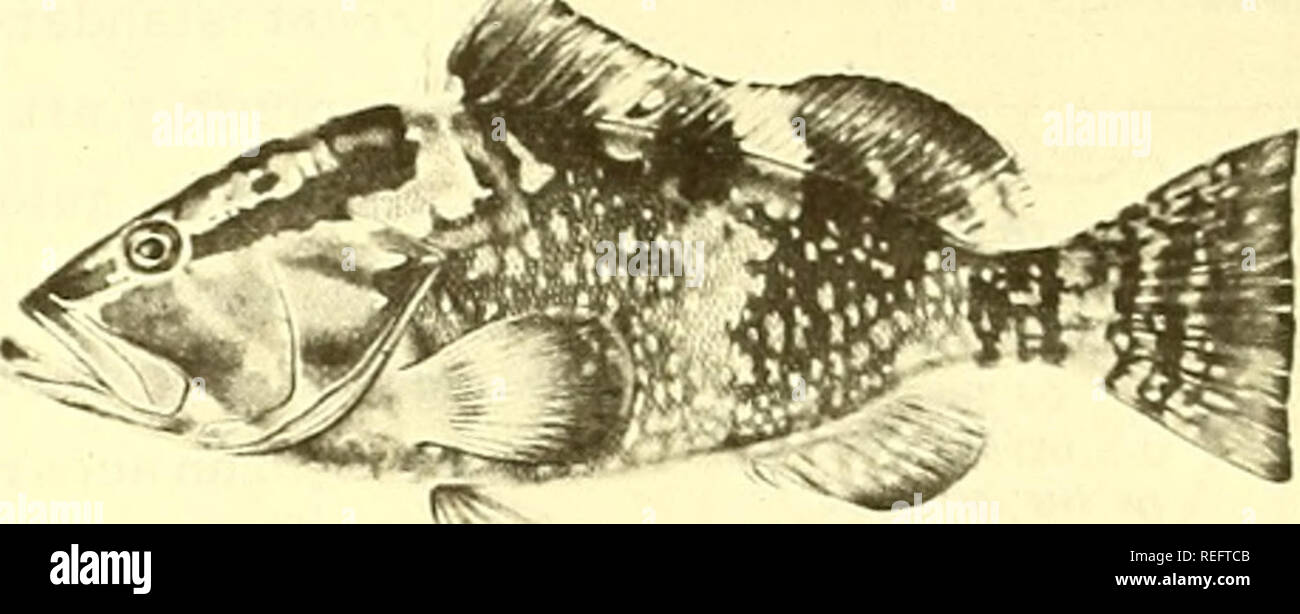. Commercial fisheries review. Fisheries; Fish trade. ^Jhe f^ed Ljrouper of the Ljulf of iv/exi ex ico Luis R. Rivas. Fig. 1 - The red grouper (Epinephelus morio). B & W photo of color plate. Adult specimen from Puerto Rico. (Evermann & Marsh, 1902.) The red grouper (Epinephelus morio) is probably the most abundant and commercially important grouper in the Gulf of Mexico, ac- cordingtoJarvis(1935: 3) and Moe (1969: 2). This is supported by records of the BCF Ex- ploratory Data Center, Pascagoula, Miss., during 1950-1970. There are 259 stations from which the red grouper was recorded--b

Image details
Contributor:
The Book Worm / Alamy Stock PhotoImage ID:
REFTCBFile size:
7.2 MB (221.5 KB Compressed download)Releases:
Model - no | Property - noDo I need a release?Dimensions:
2490 x 1004 px | 21.1 x 8.5 cm | 8.3 x 3.3 inches | 300dpiMore information:
This image is a public domain image, which means either that copyright has expired in the image or the copyright holder has waived their copyright. Alamy charges you a fee for access to the high resolution copy of the image.
This image could have imperfections as it’s either historical or reportage.
. Commercial fisheries review. Fisheries; Fish trade. ^Jhe f^ed Ljrouper of the Ljulf of iv/exi ex ico Luis R. Rivas. Fig. 1 - The red grouper (Epinephelus morio). B & W photo of color plate. Adult specimen from Puerto Rico. (Evermann & Marsh, 1902.) The red grouper (Epinephelus morio) is probably the most abundant and commercially important grouper in the Gulf of Mexico, ac- cordingtoJarvis(1935: 3) and Moe (1969: 2). This is supported by records of the BCF Ex- ploratory Data Center, Pascagoula, Miss., during 1950-1970. There are 259 stations from which the red grouper was recorded--but only 144 for the scamp (Mycteropercaphenax) and 145 for the black grouper (M. bonaci). Records for other species of groupers (Mycteroperca, Epine- phelus) are much fewer, despite the same fishing effort. Unfortunately, an index of abundance from U.S. catch statistics is not available because the various species are combined as "grou- L. R. Rivas is Staff Ichthyologist, BCF Exploratory Fishing and Cc Contribution No. 234. pers". Mexican statistics, however, distin- guish the red grouper ("mero") from other species. According to Carranza (1959: 222), the Mexican red grouper fishery of Campeche Bank is a very important source of food and revenue: it represented 66% of total fish pro- duction in 1955. Between 1950 and 1964, pro- duction of red grouper in Mexico increased from 2, 000 to 7, 000 metric tons. It declined to about 6, 450 in 1968 (Solis Ramirez, 1970). Red grouper was 77% (4, 991 m. tons) of Campeche Bank fish production in 1963; it was worth US$726, 645 (Gutierrez, 1965). It de- clined to 70% in 1967-68 (Solis Ramirez, 1970). In the United States, except for Florida Gulf coast, the red grouper catch is only in- cidental to red snapper fishery (Moe, 1969: 76; Research Base, Pascagoula, Miss. 39567. COMMERCIAL FISHERIES REVIEW Reprint No. 887 24. Please note that these images are extracted from scanned page images that may have been digitally enhanced fo